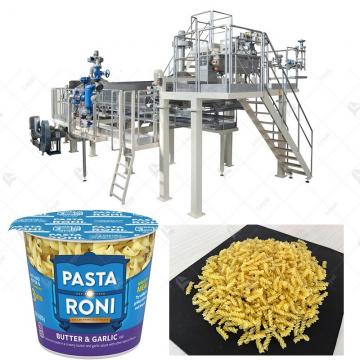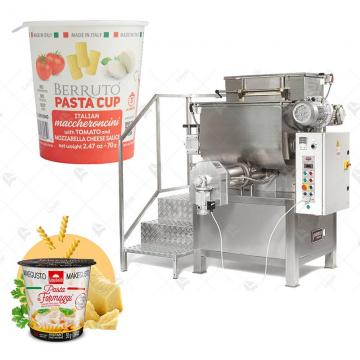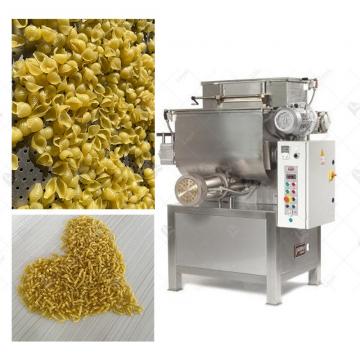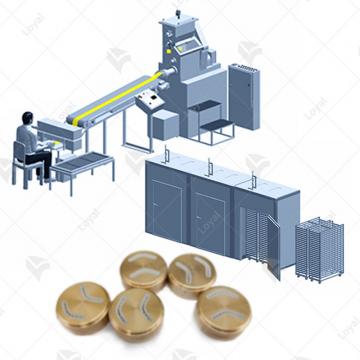
- Shandong Loyal Industrial Co.,Ltd.
- SHORT-CUT PASTA PRODUCTION LINE LONG-CUT PASTA PRODUCTION LINE INSTANT PASTA PRODUCTION LINE
Home> Company News> The Ultimate Guide To Dry Spaghetti Patsa Production Line In 2024

The Ultimate Guide To Dry Spaghetti Patsa Production Line In 2024
2024-03-28 14:18:45In the realm of culinary delights, few dishes evoke as much universal appeal and comfort as spaghetti pasta. Originating from Italy, this beloved pasta variety has become a staple in households and restaurants worldwide. At the heart of the spaghetti pasta industry lies the spaghetti pasta production line, a complex yet efficient system designed to transform simple ingredients into the iconic strands of pasta we know and love.
The spaghetti pasta production line serves as the backbone of the pasta manufacturing process, encompassing a series of meticulously orchestrated steps to ensure the creation of high-quality pasta products. From the initial handling of raw materials to the final packaging of the finished product, every stage of the production line is carefully calibrated to uphold standards of excellence and consistency.
As consumers continue to demand superior quality and variety in their pasta choices, manufacturers are constantly innovating and refining their production processes. Advanced technologies, such as automated mixing and extrusion systems, have revolutionized pasta manufacturing, allowing for greater precision and efficiency. Additionally, sustainability has emerged as a key focus area, with companies implementing eco-friendly practices and packaging solutions to minimize environmental impact.
Brief History of Spaghetti Pasta Production
Spaghetti pasta production has a rich history dating back centuries. The process of making spaghetti noodles has evolved significantly over time, with modern technology revolutionizing the production line. Let's explore the fascinating journey of spaghetti pasta production and the innovations that have shaped it into what it is today.
The origins of spaghetti can be traced back to ancient times, with evidence suggesting that early civilizations in the Mediterranean region, particularly the Greeks and Romans, consumed pasta-like dishes made from grains and water. However, it wasn't until the Middle Ages that pasta production began to resemble the process we are familiar with today.
Advantages of spaghetti pasta production line
1. Increased Efficiency: By automating the production process, spaghetti process line machines significantly increase efficiency, allowing manufacturers to produce large quantities of pasta in a shorter timeframe.
2. Consistency: The use of automated machines ensures consistency in the quality and characteristics of the pasta, such as size, shape, and texture, meeting consumer expectations consistently.
3. Cost Savings: While initial investment in spaghetti process line machines may be significant, the long-term cost savings from increased productivity and reduced labor costs justify the investment for manufacturers.
4. Customization: Advanced machines allow for easy customization of pasta products, enabling manufacturers to meet diverse consumer preferences and market demands effectively.
5. Hygiene and Safety: Spaghetti pasta production line machines are designed with hygiene and safety in mind, incorporating features such as stainless steel construction, easy-to-clean surfaces, and adherence to food safety standards.
6. Market Competitiveness: Adopting spaghetti pasta production line machines enhances a manufacturer's competitiveness in the market by improving product quality, reducing lead times, and responding promptly to changing consumer trends.
Application of Spaghetti Pasta Production Line Machines
Spaghetti pasta production line machines have found widespread application in the food industry, revolutionizing the way pasta is manufactured. These machines, equipped with advanced technology and automation features, play a crucial role in ensuring efficiency, consistency, and quality in pasta production processes.
One key application of pasta factory machine line machines is in the extrusion process. Utilizing precise control over factors such as dough consistency and extrusion speed, these machines shape the pasta dough into uniform spaghetti strands. This results in consistent size and shape, meeting consumer expectations and enhancing the overall product quality.
Moreover, the automation capabilities of these machines streamline the production process, reducing the need for manual intervention and minimizing labor costs. Automated systems monitor and adjust various parameters, such as ingredient proportions and drying conditions, to maintain optimal production conditions and ensure product uniformity.
Another important application is quality control. Pasta factory machine line machines employ advanced systems to monitor and maintain strict quality standards throughout the manufacturing process. By closely monitoring factors like ingredient quality and extrusion parameters, manufacturers can consistently produce pasta with desired texture, flavor, and appearance.
Furthermore, the application of spaghetti pasta production line machines enables cost savings for manufacturers. By optimizing production processes and reducing manual labor requirements, these machines improve operational efficiency and minimize overhead costs. This cost-effectiveness contributes to the overall competitiveness of pasta manufacturers in the market.
Components of a Spaghetti Pasta Production Line
A pasta factory machine line consists of several key components that work together seamlessly to produce high-quality spaghetti noodles efficiently. These components include:
1. Mixing and Kneading Machines:The process begins with mixing and kneading machines, which combine durum wheat semolina flour with water to create a dough. This dough is then kneaded to the proper consistency, ensuring that the gluten in the flour is adequately developed for optimal texture and elasticity in the final pasta product.
2. Extrusion Equipment:Once the dough has been properly kneaded, it is fed into extrusion equipment, which shapes the dough into long, thin strands of spaghetti. This equipment typically consists of a series of dies and rollers that extrude the dough through small holes, forming the familiar cylindrical shape of spaghetti noodles.
3. Drying Tunnels:After extrusion, the spaghetti noodles pass through drying tunnels, where they are exposed to controlled temperatures and humidity levels to remove excess moisture. This process is crucial for preserving the shelf life of the pasta and ensuring that it maintains its shape and texture during storage and transportation.
4. Cutting and Sorting Machines:Once the spaghetti noodles have been dried to the proper moisture content, they are cut into uniform lengths by cutting and sorting machines. These machines use high-speed blades or lasers to precisely cut the noodles to the desired length, ensuring consistency in size and appearance.
5. Packaging Equipment:Finally, the dried and cut spaghetti noodles are packaged using automated packaging equipment. This equipment fills bags or boxes with the noodles, seals them for freshness, and labels them with product information and branding. Packaging equipment may also include metal detectors and weight-checking systems to ensure product quality and compliance with regulatory standards.
In addition to these primary components, a spaghetti pasta production line may also incorporate various ancillary equipment, such as flour sifters, dough feeders, conveyor belts, and quality control systems, to further streamline the production process and enhance product quality and consistency.
Quality Control Measures in Spaghetti Pasta Production
In the pasta factory machine line, ensuring quality control measures is paramount to maintaining the integrity and consistency of the final product. From the initial processing stages to the packaging phase, every step must adhere to stringent standards to guarantee customer satisfaction and compliance with food safety regulations.
Spaghetti process line begins with the selection of high-quality durum wheat, which is then milled into semolina flour. This flour serves as the primary ingredient in spaghetti production and must undergo rigorous testing for moisture content, protein levels, and gluten strength. Any deviations from the specified parameters can significantly impact the texture and cooking properties of the pasta.Once the semolina flour passes quality inspection, it is mixed with water to form a dough, which is then kneaded and extruded through a die to create the characteristic spaghetti strands. Throughout this process, temperature and humidity controls are critical to maintaining consistency and preventing sticking or breakage.
After extrusion, the spaghetti strands are cut to the desired length and transferred to a drying chamber. Proper drying is essential for removing excess moisture and ensuring shelf stability. Quality control measures during this phase include monitoring drying temperatures, air circulation, and moisture levels to prevent over-drying or under-drying.Once dried, the spaghetti undergoes further inspection for defects such as cracks, discoloration, or irregular shapes. Automated optical sorting systems are often employed to detect and remove any flawed strands, ensuring only the highest quality pasta reaches the packaging stage.
Packaging is the final step in the spaghetti pasta production line, where the product is sealed in airtight containers to preserve freshness and prevent contamination. Quality control measures in packaging include weight checks, seal integrity tests, and visual inspections to verify proper labeling and product presentation.Throughout the entire spaghetti production process, comprehensive record-keeping is essential to track raw materials, production parameters, and quality control checks. This data allows for traceability and facilitates prompt corrective action in the event of any deviations from established standards.
In conclusion, maintaining quality control measures in the spaghetti pasta production line is essential for delivering a superior product that meets consumer expectations and regulatory requirements. By implementing stringent protocols at every stage of production, manufacturers can ensure consistency, safety, and satisfaction with their spaghetti products.
Routine Maintenance of Spaghetti Pasta Production Line
Maintaining a spaghetti pasta production line is crucial for ensuring efficient operations and high-quality pasta output. Routine maintenance not only helps prevent unexpected breakdowns but also prolongs the lifespan of the equipment. In this article, we'll discuss the key steps involved in the routine maintenance of a spaghetti pasta production line.
1. Cleaning: Regular cleaning is essential to prevent the buildup of debris and contaminants in the production line. This includes cleaning the conveyor belts, pasta extruders, drying racks, and packaging equipment. Use food-grade cleaning agents and follow manufacturer guidelines for best results.
2. Lubrication: Proper lubrication of moving parts is vital to reduce friction and wear. Check and lubricate bearings, gears, and other mechanical components according to the manufacturer's recommendations. Using the wrong type of lubricant can damage the equipment, so always use the specified lubricants.
3. Inspection: Conduct regular inspections of the production line to identify any signs of wear or damage. Look for worn-out parts, loose connections, and leaks. Replace any damaged components promptly to prevent further problems.
4. Calibration: Ensure that the equipment is properly calibrated to maintain consistent pasta quality. This includes checking the temperature, pressure, and speed settings of the pasta extruder and drying oven. Make adjustments as necessary to meet the desired specifications.
5. Electrical Maintenance: Inspect electrical components such as wiring, switches, and control panels for signs of damage or overheating. Tighten connections and replace faulty components to prevent electrical hazards.
6. Safety Checks: Regularly inspect safety features such as emergency stop buttons, safety guards, and interlocks. Ensure that they are functioning correctly to protect workers from accidents.
7. Training: Provide training for operators and maintenance staff on proper equipment operation and maintenance procedures. This will help ensure that everyone knows how to safely and effectively maintain the production line.
Automation and Robotics for Increased Efficiency
In the contemporary landscape of food manufacturing, spaghetti pasta production lines are witnessing a revolutionary transformation propelled by advancements in automation and robotics. This convergence of technology has significantly enhanced efficiency, productivity, and quality across the entire production process.
One of the pivotal areas where automation and robotics have made substantial strides is in the raw material handling phase. Automated systems equipped with sensors and actuators precisely measure and dispense ingredients such as semolina flour and water, ensuring optimal consistency and uniformity in the pasta dough. This automated precision not only reduces material wastage but also guarantees the desired texture and taste in the final product.
Moreover, automation and robotics have revolutionized the extrusion and shaping stage of spaghetti pasta production. Sophisticated machinery, guided by computer algorithms, precisely shapes the pasta dough into uniform strands with consistent thickness and length. This level of precision was previously unattainable with manual labor, leading to enhanced product quality and customer satisfaction.
Furthermore, the integration of automation and robotics in the drying and packaging phase has streamlined operations and minimized human intervention. Robotic arms equipped with advanced gripping mechanisms delicately handle the freshly extruded pasta strands, arranging them on drying racks with utmost precision. Once dried to perfection, automated packaging systems swiftly package the spaghetti into standardized quantities, ready for distribution.
The adoption of automation and robotics in spaghetti pasta production not only boosts efficiency but also ensures stringent adherence to quality and safety standards. Automated systems can monitor critical parameters such as temperature, humidity, and processing times with unparalleled accuracy, mitigating the risk of contamination and ensuring product consistency batch after batch.
Moreover, the implementation of automation and robotics has significantly reduced labor costs and minimized the reliance on manual labor, thereby enhancing overall operational efficiency and profitability. By automating repetitive and labor-intensive tasks, manufacturers can reallocate human resources to more value-added activities such as research and development or quality control.
In conclusion, the integration of automation and robotics has revolutionized the spaghetti pasta production line, driving unprecedented levels of efficiency, quality, and consistency. By harnessing the power of technology, manufacturers can meet the growing demands of consumers while staying competitive in a dynamic market landscape. As the industry continues to evolve, the synergy between automation, robotics, and traditional pasta-making techniques will pave the way for further innovations and advancements.
Advanced Extrusion Techniques for Superior Pasta Quality
Another key innovation in spaghetti pasta production is the development of advanced extrusion techniques. Spaghetti process lines now utilize cutting-edge extruders equipped with precision nozzles and dies that allow for the creation of pasta strands with consistent thickness and texture. Additionally, manufacturers have introduced innovative formulations and blends of durum wheat flour and water to produce spaghetti that boasts superior taste, texture, and cooking properties. These advancements ensure that every strand of spaghetti meets the highest standards of quality and taste.
Sustainable Practices in Production and Packaging
In recent years, there has been a growing emphasis on sustainability in spaghetti pasta production. Manufacturers are adopting eco-friendly practices throughout the entire production process, from sourcing raw materials to packaging the final product. For instance, many companies are investing in energy-efficient machinery, optimizing water usage, and reducing waste generation. Moreover, there is a shift towards using biodegradable and recyclable packaging materials to minimize the environmental impact of spaghetti pasta production. By embracing sustainable practices, manufacturers are not only reducing their carbon footprint but also meeting the growing consumer demand for environmentally responsible products.
Integration of Smart Technologies for Process Optimization
The integration of smart technologies has also played a significant role in optimizing spaghetti pasta production. Spaghetti production lines are now equipped with sensors, actuators, and data analytics tools that monitor and control various aspects of the manufacturing process in real-time. These smart systems can adjust parameters such as temperature, humidity, and extrusion speed to ensure optimal pasta quality and consistency. Furthermore, predictive maintenance algorithms help identify potential equipment failures before they occur, minimizing downtime and maximizing productivity. By harnessing the power of data and analytics, manufacturers can continuously improve their spaghetti pasta production processes and stay ahead of the competition.
Market Trends and Future Outlook for Spaghetti Pasta Production
In recent years, the spaghetti pasta production line industry has witnessed significant growth and evolution due to shifting consumer preferences and emerging market trends. This article explores the current state of the market, predicts future developments, and identifies opportunities for growth and expansion.
Spaghetti has long been a staple in households worldwide, but its consumption patterns have been evolving. One notable trend is the increasing demand for healthier alternatives, such as whole wheat or gluten-free options. Consumers are becoming more health-conscious, driving manufacturers to innovate and offer products that cater to these preferences.
Moreover, convenience plays a crucial role in modern lifestyles, leading to the rise of ready-to-cook or pre-packaged spaghetti products. Busy consumers seek quick and easy meal solutions without compromising on taste or quality. As a result, manufacturers are investing in efficient spaghetti process lines to meet this demand for convenience while maintaining high standards of production.
The spaghetti pasta production industry is also witnessing a shift towards sustainable practices and ethical sourcing. Consumers are increasingly concerned about the environmental impact of food production and are seeking products that align with their values. This has led to a growing demand for organic ingredients, eco-friendly packaging, and transparent supply chains.
Additionally, there is a rising interest in ethnic or regional varieties of spaghetti, reflecting a broader trend towards culinary diversity. Consumers are eager to explore new flavors and experiences, prompting manufacturers to diversify their product offerings and adapt to changing tastes.
Looking ahead, the future of spaghetti pasta production lines appears promising yet challenging. Rapid urbanization, changing dietary habits, and technological advancements will continue to shape the industry landscape.
One notable development is the integration of automation and artificial intelligence (AI) technologies into production processes. This enables manufacturers to improve efficiency, reduce costs, and ensure consistent quality. However, it also raises concerns about job displacement and the need for upskilling the workforce.
Furthermore, globalization presents both opportunities and threats for the industry. On one hand, it opens up new markets and distribution channels, allowing manufacturers to reach a broader audience. On the other hand, increased competition and trade barriers may pose challenges for domestic producers.
Despite these challenges, there are several opportunities for growth and expansion in the spaghetti pasta production industry. Diversification of product offerings, investment in research and development, and strategic partnerships can help manufacturers stay competitive and meet evolving consumer demands.
Moreover, expanding into emerging markets and leveraging e-commerce platforms can provide access to new customers and drive sales growth. By embracing innovation and adopting a customer-centric approach, spaghetti pasta production companies can position themselves for success in the dynamic marketplace.
In conclusion, the spaghetti pasta production industry is undergoing significant transformation driven by changing consumer preferences, technological advancements, and global market dynamics. By staying agile and proactive, manufacturers can capitalize on emerging trends and secure their place in the future of food production.
References
1. European Food Research and Technology (https://www.springer.com/journal/217)
2. Journal of Food Process Engineering (https://onlinelibrary.wiley.com/journal/17454522)
3. Food and Bioprocess Technology (https://www.springer.com/journal/11947)
4. Journal of Cereal Science (https://www.journals.elsevier.com/journal-of-cereal-science)
5. International Pasta Organisation (IPO) (https://www.internationalpasta.org/)
FAQs: Frequently Asked Questions
Q: How often should routine maintenance be performed on a spaghetti pasta production line?
A: Routine maintenance should be performed regularly, ideally on a weekly or monthly basis, depending on the production volume and the manufacturer's recommendations.
Q: What are the common issues that may arise in a spaghetti pasta production line?
A: Common issues include clogging of pasta extruders, conveyor belt misalignment, overheating of drying ovens, and packaging machine malfunctions.
Q: Can I use any type of lubricant for the equipment?
A: No, it's essential to use food-grade lubricants approved for use in food processing equipment to ensure food safety and equipment performance.
Q: How can I minimize downtime during maintenance?
A: Proper planning, regular inspections, and preventive maintenance can help minimize downtime. Additionally, having spare parts on hand can reduce the time needed for repairs.
 Instant Pasta Production Line
Instant Pasta Production Line INSTANT PASTA CUP PRODUCTION LINE
INSTANT PASTA CUP PRODUCTION LINE PRECOOKED PASTA PRODUCTION LINE
PRECOOKED PASTA PRODUCTION LINE Dry Pasta Production Line
Dry Pasta Production Line